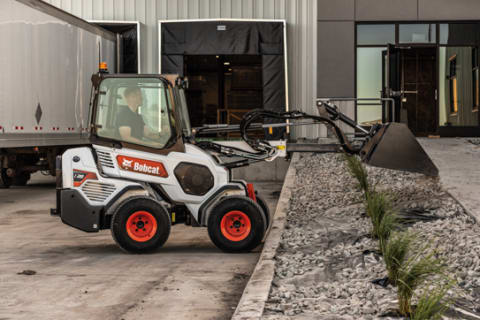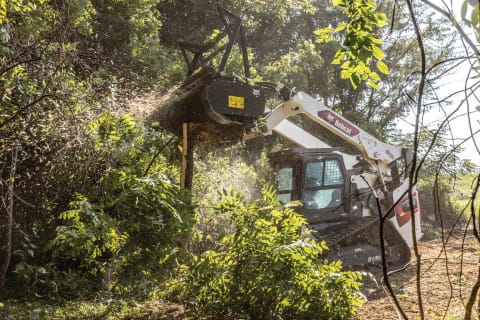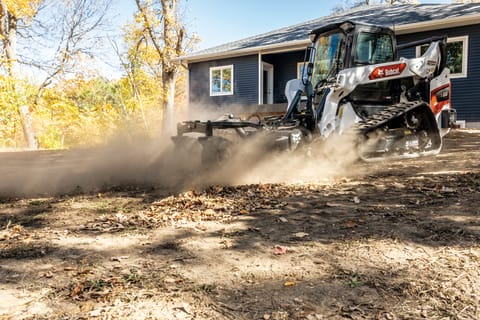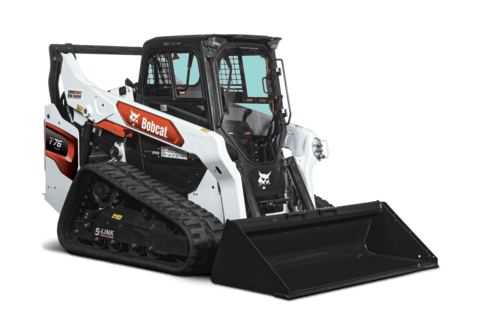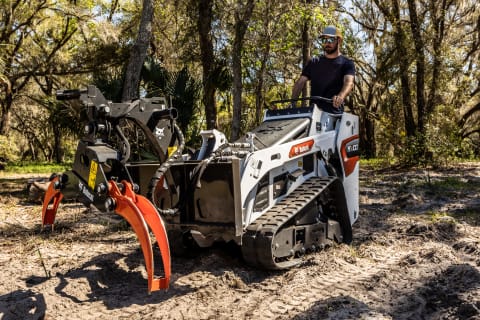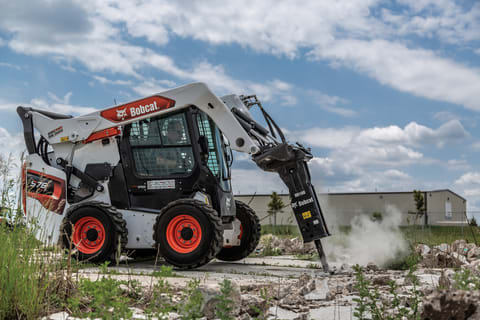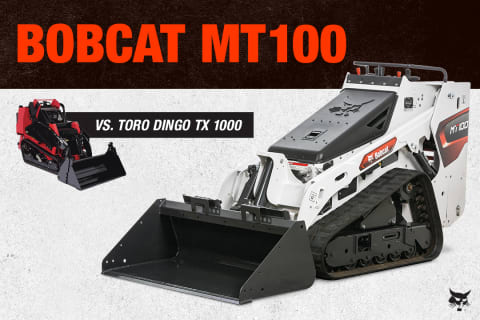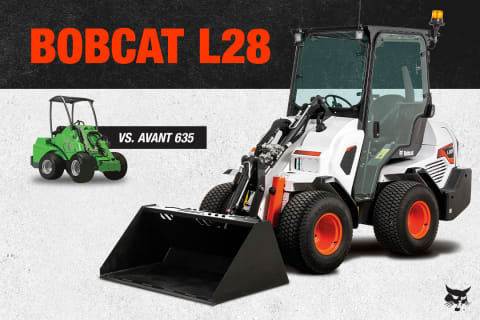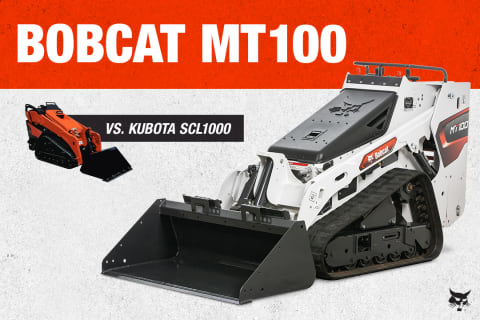- Home
- Buying Resources
- Loaders
- Skid-Steer Loader Winter Season Maintenance Tips & Checklist
Build Your Loader, Get a Free Price Quote
Customize your loader. Select the model, choose options, and submit to your local dealer for a free price quote.
Build & QuoteBobcat Maintenance Checklist To Keep Your Skid-Steer Loader From Taking a Snow Day
Posted on February 5, 2020
Before you let your skid-steer loader out to take on the snow, follow this seasonal maintenance checklist.
Summary
When a project calls for winter work, contractors count on skid-steer loaders and compact track loaders to keep the operation running. Skid-steer and compact track loaders are tough enough to make the transition to the cold.
And they have the versatility to move from general construction and landscaping work to snow removal with ease. Before you let your skid-steer or track loader out to take on the snow, follow this seasonal Bobcat loader maintenance checklist.
Change fluids with the season
There’s nothing like an insulated mug of hot coffee to get you through a brisk winter’s day. If your compact loader could talk, it would tell you the same. Follow your Bobcat compact loader maintenance schedule and fill up with the proper cold-weather engine oil, coolant, hydraulic oil and fuel to help minimize maintenance problems.
-
Engine oil – You’ll need an engine oil viscosity that matches the temp outside. A 10W-30 is a common factory-fill that performs down to minus 20 degrees Fahrenheit. For better cold-weather starting and lubrication, use a 5W-40 synthetic oil, which typically protects down to 40 below zero.
-
Engine coolant – Antifreeze is just as important for your compact loader as it is for your car or truck. Test it and top it off before work begins.
-
Hydraulic oil – Synthetic blends provide good cold-weather fluidity. Depending on where you live, you may need a high-performance hydraulic lubricant. They’re custom blended to give your compact loader peak flow in subzero temps.
-
Diesel fuel – In extreme cold, diesel fuel will gel. Normally, a No. 2 grade diesel fuel may be fine, but you will want to switch to an alternative diesel fuel if an extended cold snap is coming your way. If the temperature will be above 15 degrees Fahrenheit, you can use 100% Grade 2-D fuel. For temperatures down to minus 5 F, use 50% Grade 2-D fuel and 50% Grade 1-D fuel. Switch to 100% Grade 1-D fuel for temperatures below minus 5 F.
Your compact loader Operation & Maintenance Manual has recommended maintenance schedules and oil change intervals, fluids and fuels specific to your machine and cold weather conditions. Double-check your loader manual before you change fluids to match the season.
Get a Free Price Quote From Your Local Dealer
Find A DealerFill up cold loader tires
Remember that experiment from science class where the balloon shrinks from the cold? The same thing happens to your tires. When the temperature drops, so does the tire pressure. Cold weather also makes the rubber stiffer. If you notice your tires sagging after a dip in temp, fill them up to capacity. Repair any leaks suffered in the busy season during your regular maintenance schedule.
A small leak or nail in the tire is easy to put off in warmer weather – you may only have to fill your tire once a week. In winter, once a week can turn into once a day. You’ll eliminate a lot of wasted time and ensure that low tire pressure doesn’t drain your pushing and lifting power throughout the day.
Charge the compact loader’s battery
It takes a little longer to get going in the mornings when it’s cold – for both you and your compact loader. You layer up and crank the heat to power through, only to find that your skid-steer or compact track loader can’t even power up. Freezing temps force your compact loader’s battery to crank twice as hard to turn over, deliver fuel to the engine and start up.
Before the next project or snowfall, run a load test and check wires and connections for wear or corrosion. Even a small defect can result in a loss of cranking amps, leaving you with a dead battery, freezing your project.
Check the loader cab’s comfort features
Your mom never let you go out into the cold without a stocking cap. Smart woman. Freezing temps are no time to test your toughness. Don’t let your skid-steer or compact track loader leave the garage after its scheduled maintenance without checking everything that keeps the cab warm. Inspect the door and window seals to make sure heat won’t escape.
Test that the heating, defogging and defrosting systems are all working, and get the heated seat turned on and warmed up. If any of those systems go out on the job, it will make for a long, uncomfortable day for you or another operator.
Prep commonly used attachments
You dreaded shoveling as a kid. Digging out of a snowstorm meant hours of back-breaking labor – and less fun in the snow. If only you had a Bobcat compact loader back then. With the right attachment, a loader transforms into a snow removal machine. Plus, changing hydraulic attachments is fast and easy with the Bob-Dock attachment mounting system.
Attachments deserve the same level of maintenance attention as the loader itself during your scheduled maintenance checkup. Inspect the hoses, cylinders and guards, cutting blades and edges for signs of wear or damage. If the attachment requires maintenance or lubrication, check the fluid levels before you head out into the cold. This is especially important for snow removal attachments that have been collecting dust in your garage since last winter.
Construction projects don’t shut down for three months just because it’s a little chilly. Sure, the weather plays a bigger role. But many jobs move along as if winter never came. Talk to your dealer about the preventive maintenance steps on this checklist and the snow removal attachments you need to keep your machine from taking a snow day.
Learn more about what oil is best for your machine.
Explore More Loader Resources
View All Articles- Small Articulated Loaders Productivity for Grounds Maintenance
Small Articulated Loaders Productivity for Grounds Maintenance
Learn about how versatile and powerful small articulated loaders increase productivity and their advantages for ground-maintenance and landscaping professions. - How Compact Loaders are Beneficial for Forestry Work
How Compact Loaders are Beneficial for Forestry Work
Learn how Bobcat compact track loaders and skid-steer loaders provide versatility with attachments and machine power to increase your productivity for forestry work. - Landscaping Attachments for Compact Loaders
Landscaping Attachments for Compact Loaders
Explore the top landscaping attachments for your compact loaders, like compact track loaders for versatile productivity and power on the job. - Section 179 Tax Deduction for Compact Equipment
Section 179 Tax Deduction for Compact Equipment
Leverage IRS Section 179 for small business tax benefits to deduct the full purchase (or lease) on qualifying compact equipment during the tax year. Learn more. - Top Attachments for Mini Track Loaders
Top Attachments for Mini Track Loaders
Discover the top attachments from the 24 available for the Bobcat Mini Track Loaders for job-specific landscaping, grounds maintenance and forestry challenges. - Bobcat Attachments for Concrete Work with Compact Loaders
Bobcat Attachments for Concrete Work with Compact Loaders
Learn why Bobcat loaders are the machines of choice for concrete contractors with the productivity increase of Bobcat attachments specifically for concrete work. - How to Choose Compact Track Loader Tracks
How to Choose Compact Track Loader Tracks
The right compact track loader tracks can improve your machine’s performance, minimize ground disturbance and extend your working season in wetter months. - Bobcat MT100 vs. Toro Dingo TX 1000
Bobcat MT100 vs. Toro Dingo TX 1000
When choosing a mini track loader, it is important to examine key features and benefits. Explore how the Bobcat MT100 stacks up against the Toro Dingo TX 1000. - Bobcat L28 vs. Avant 635 Small Articulated Loader
Bobcat L28 vs. Avant 635 Small Articulated Loader
Small articulated loaders provide impressive lifting capabilities. When looking at the Bobcat L28 compared to the Avant 635, here are some factors to consider. - Bobcat MT100 vs Kubota SCL1000
Bobcat MT100 vs Kubota SCL1000
Every feature and specification matters, to obtain maximum production and output from a mini track loader. Compare the Bobcat MT100 against the Kubota SCL 1000.
